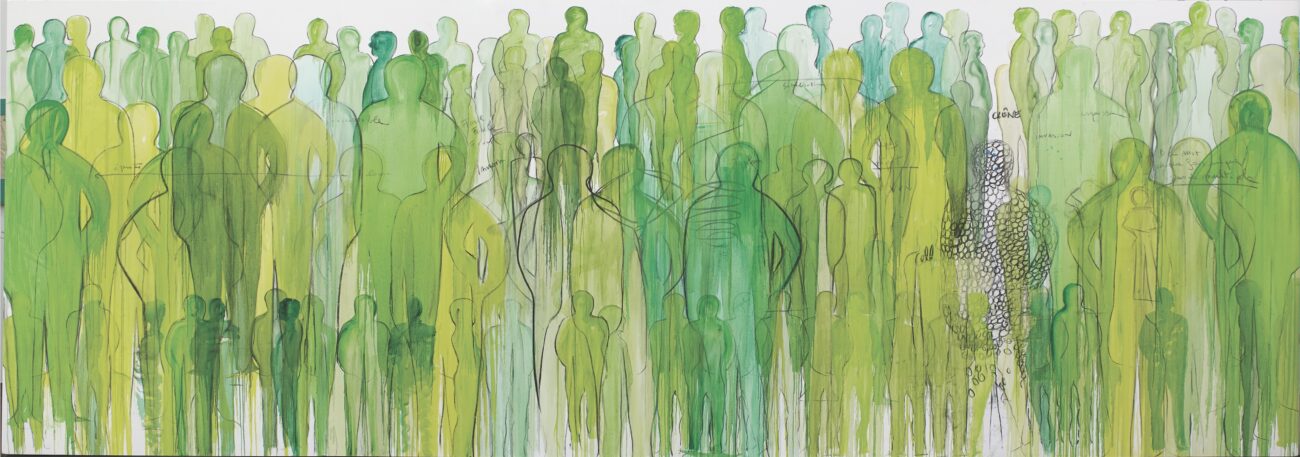“Siamo Foresta” is an exhibition promoted by Triennale Milano and Fondation Cartier that explores the relationship between humans and the environment, using the forest as a symbol for a social, spiritual, and political discourse
Triennale di Milano Milan
From June 21, 2023, to October 29, 2023
Words DOMENICO COSTANTINI
In an era of ecological crisis like this, artistic practices that question the centrality of human beings in relation to the natural environment are spreading in public discourse, emphasizing a post-anthropocentric worldview. In this context, the forest, both as a physical space for individual experiences and as a symbolic meeting point for artistic practices, represents the core of the exhibition. Through the works of twenty-seven artists, primarily from Latin America, many of whom belong to indigenous communities, an intercultural dialogue is established, where different forest imaginaries and their evocative power branch out into a plurality of voices that invite the viewer to reflect on their role within the biosphere and, through intercultural dialogue, to identify the common roots of human beings.
As Bruce Albert, anthropologist and co-artistic director of the exhibition, explains: “Siamo Foresta draws its inspiration from a shared aesthetic and political vision of the forest as an egalitarian multiverse of living peoples, both human and non-human, and as such, it offers a vibrant allegory of a possible world beyond our anthropocentrism. From its origins, Western tradition has divided and hierarchized living beings according to a scale of values in which human beings constitute the apex. This human supremacy has progressively alienated humanity from the rest of the living world, paving the way for all the abuses that have resulted in the destruction of biodiversity and the current climate catastrophe.”
In a collaborative system based on the potential connectivity of the forest, indigenous artists from New Mexico to Paraguayan Chaco, to the Amazon (Brazil, Peru, and Venezuela) meet creative voices from urban realities in Brazil, China, Colombia, and France. Some of these encounters have generated unprecedented artworks and exchanges between seemingly distant worlds. For instance, we see the Venezuelan Yanomami artist Sheroanawe Hakihiiwe collaborating in the spring of 2023 with French artist Fabrice Hyber, who was featured on our magazine’s latest cover. Adriana Varejão from Rio de Janeiro collaborated with Joseca Mokahesi, a Yanomami artist from Brazil, in 2003. There is also a recent collaboration between Ehuana Yaira, a Brazilian Yanomami, and Cai Guo-Qiang of Chinese origin. The cross-pollination of diverse practices and perspectives becomes an opportunity to give space to mostly unknown voices, yet to be canonized within the European art world.
Bruce Albert narrates: “Brazilian art, for example, has experienced four years under the dictatorship of Bolsonaro, who has harshly attacked artists. However, it seems that from this threat and contraction of freedoms, there has emerged a unique artistic effervescence and richness. There is a wealth and proliferation of Brazilian art and very interesting artists who are still unknown in Europe. Latin American art, in general, seems to possess a special creativity fueled by the political difficulties faced by different countries. Indigenous artists, in particular, are doubly oppressed, both by the national political system and the lack of resources at the local level. For them, art has become a powerful political tool to make their culture and existence known and to garner support for the causes they defend. The conception of the forest for these peoples goes beyond a simple definition of a ‘collection of trees.’ The forest represents a global world in which all living beings, human and non-human, coexist on a plane of equity, dignity, and sensitivity.”

Paintings and drawings on large canvases created by Sheroanawe Hakiihiwe and Fabrice Hyber during their experience in the forest called La Vallée in France open the exhibition’s path. Fabrice Hyber often compares his creative process to the organic growth of living beings. On his canvases, the artist formulates hypotheses, associates ideas, and invents forms, offering an intuitive and poetic observation of the ever-changing transformations of living beings and a dreamlike vision of the hybridization between humans and plants. As an advocate of positive ecology, he is interested in the infinite possibilities of regeneration in the living world.
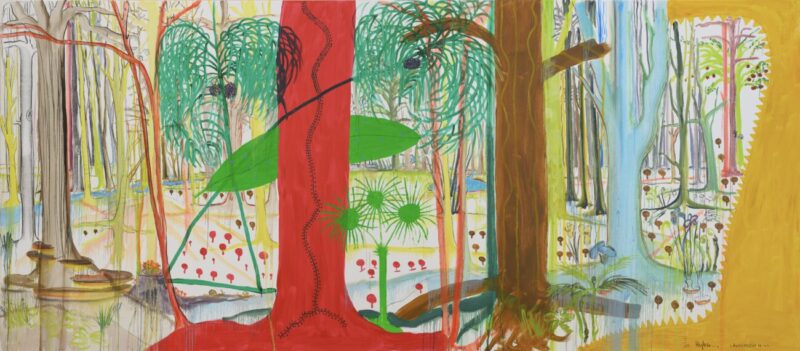
In contrast, Luiz Zerbini‘s pictorial landscapes represent a kind of urban forest where it is difficult to distinguish whether wild nature prevails over the city or vice versa. His works, which include paintings, photographs, engravings, and installations, are characterized by a strong interest in landscape and botany, presenting an intricate dialogue between abstraction, geometry, and figuration.

Plants, animals, and fossils extend within the painting “Mundao II” by artist Solange Pessoa, a representation that embraces forgotten stories. Furthermore, the monochromatic drawings of chimera birds depict possible primitive forms that the artist imagines in constant transformation, similar to the characters of indigenous myths present in the works of Esteban Klassen, Angelica Klassen, Floriberta Fermin, and Efacio Alvarez. These artists are part of the indigenous Nivaklé community and portray in black and white the exceptional diversity of plant and animal species at risk of extinction that populate the forest of the Paraguayan Gran Chaco, as well as the shamanic cosmology of their people.
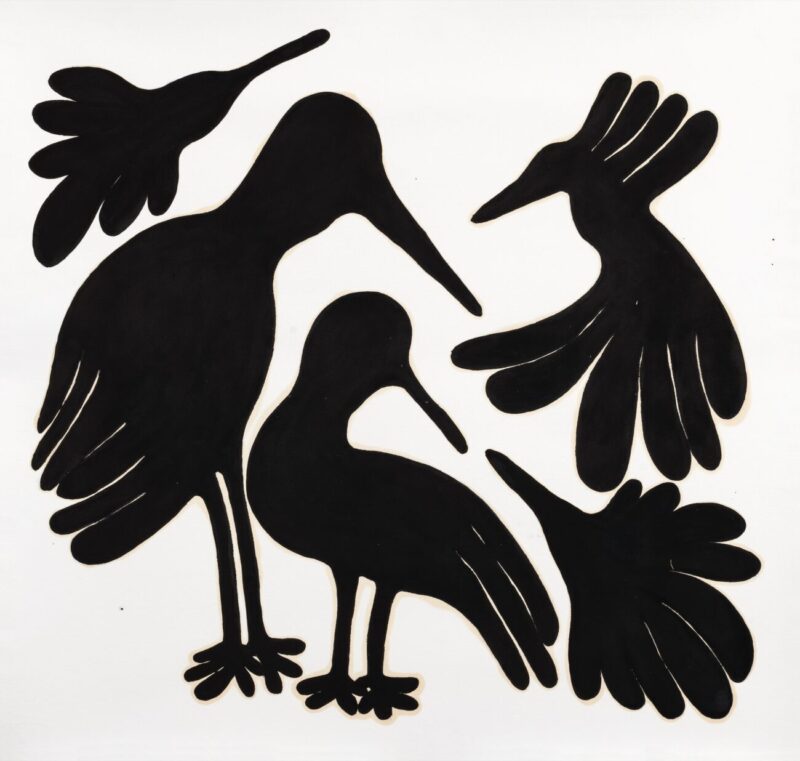

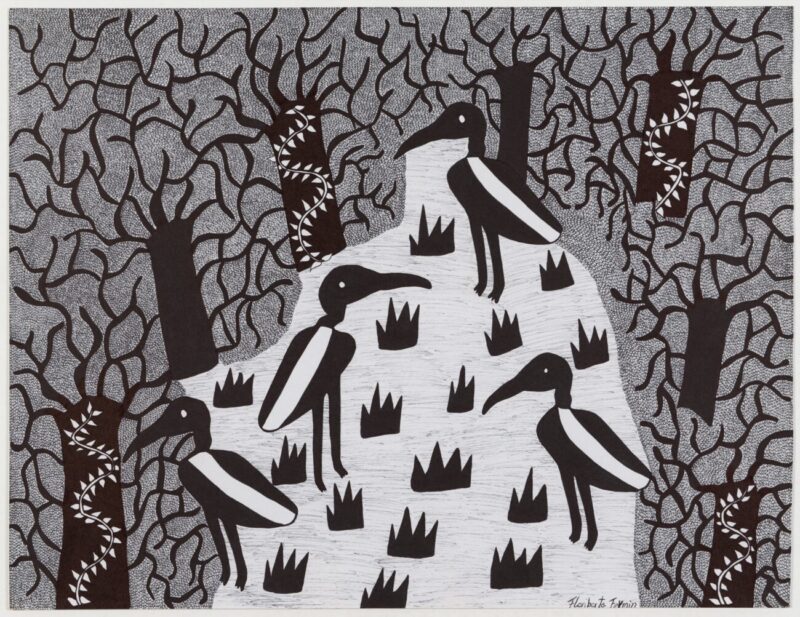
Virgil Ortiz, an artist from the Cochiti Pueblo community in New Mexico, United States, continues the tradition of figurative pottery in his community by creating original figures based on a regional style of social caricature that has roots in the 19th century and draws inspiration from the characters and spectators of traveling circuses that passed through the region during that time. Brus Rubio Churay, a self-taught painter from the Peruvian Amazon, addresses historical, social, and political themes that have impacted his people, the Murui-Bora, and the Amazon region as a whole, such as oppression, resource exploitation, and pollution. His works reinterpret the traditional myths and rituals of the Murui-Bora through the creation of hybrid characters, part human and part animal or plant, moving through the air of a lush ancestral forest.
The painting “Cadernos de viagem, connaissance par corps” by artist Adriana Varejão and the drawing “Becoming a Shaman” by artist Joseca Mokahesi emphasize the deep connection between the two works that underlies their artistic conception. Many Yanomami drawings are linked to shamanism, such as those by Joseca Mokahesi, depicting the visions recounted in the songs of the elders, and those by Ehuana Yaira, representing female characters from Yanomami mythology. The works of Cleiber Bane, a Brazilian artist from the Huni Kuin community, depict in images the ritual chants of his people, creating true shamanic scores.
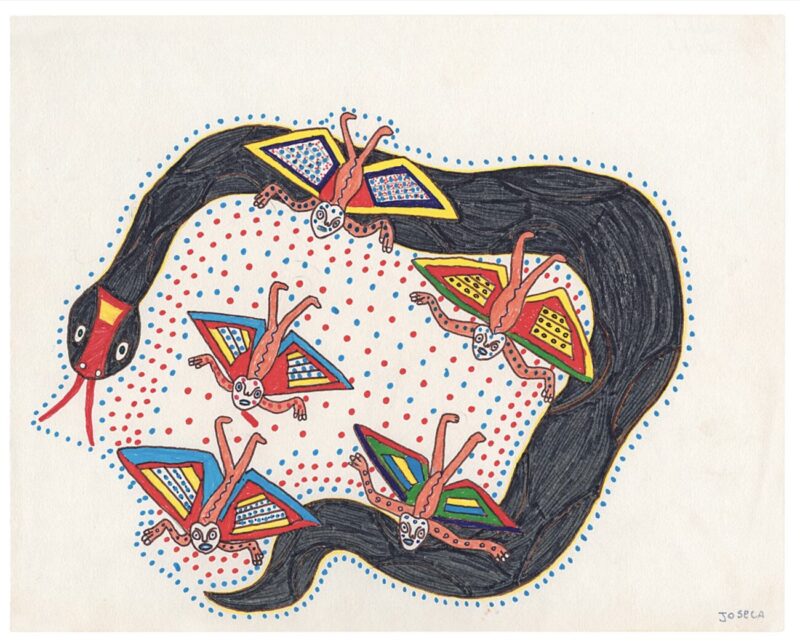
Jaider Esbell, an activist artist, merges the bestiary of the Makuxi people’s mythology from the northern Brazilian Amazon with the cosmological dreams of the author. The artist Bruno Novelli combines fantastical animals and dreamlike tropical landscapes, created with colorful geometric patterns. In his imagined forests, landscapes, animals, and plants from various inspirations intertwine, ranging from medieval frescoes to indigenous Amazonian symbolism. Similarly, Alex Cerveny paints fantastical worlds where humans, biblical or mythological characters, are closely associated with tree forms, eventually becoming trees themselves. Cerveny seeks a profound union between humans and non-humans, drawing inspiration from the indigenous cultures of the Brazilian Amazon rainforest.
Johanna Calle, a Colombian artist, creates an ethereal outline of a large tree using typewritten texts on notarial paper from a law regarding the restitution of land to indigenous peasants (from the Fondation Cartier collection). Planting trees becomes a way for these farmers, who cannot afford to erect fences, to legitimize their ownership of the cultivated land. Additionally, three films showcase the indigenous communities of the Yanomami people from the northern Brazilian Amazon and the Nivaklé and Guarani people from the Gran Chaco region in Paraguay. The works illustrate the richness of their cultures and the environmental changes that threaten their traditional ways of life. They offer a unique and intimate view of these communities, raising awareness about the challenges they face and the need to preserve the cultural and environmental diversity of the Amazon rainforests.
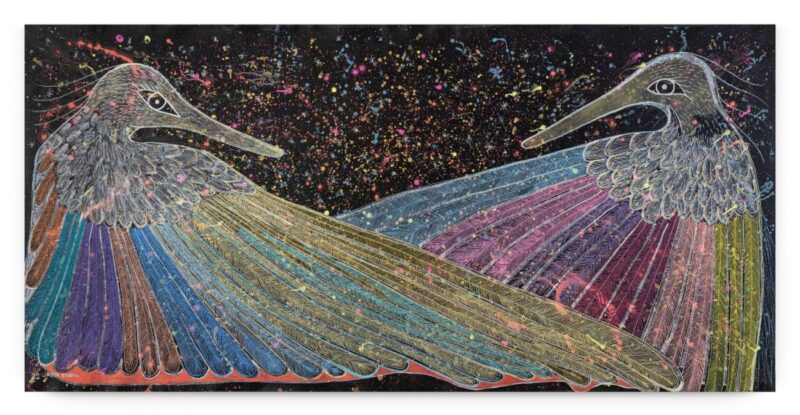
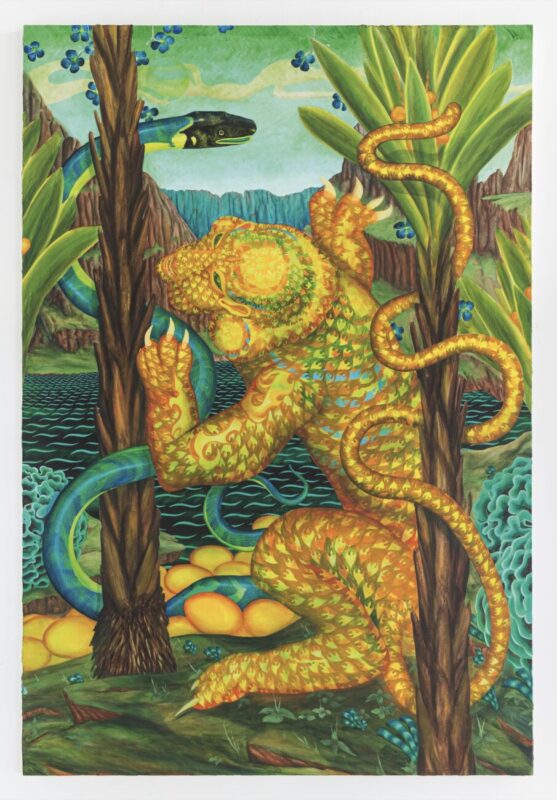

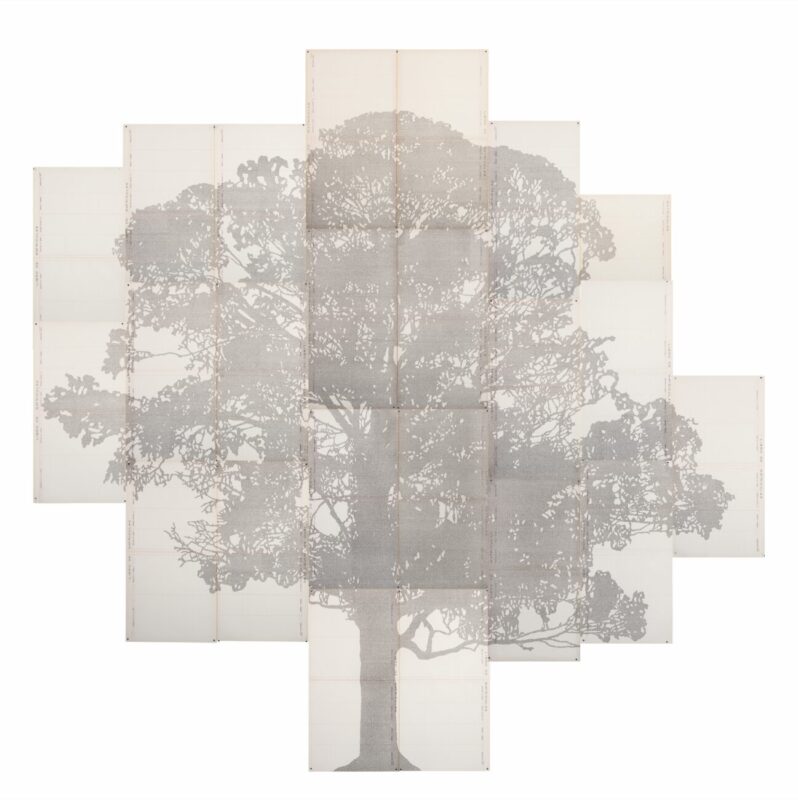
“Siamo Foresta” brings together artists from diverse cultures who are inspired by nature, mythology, shamanism, and the struggles of Amazonian indigenous peoples. Through paintings, drawings, installations, and collaborative works, the exhibition invites us to explore the interconnectedness of living things and to reflect on the importance of preserving and enhancing the biological and cultural diversity of forests and the peoples who inhabit them.
